In accordance with longstanding European gunmaker custom, CZ ships a test target with its pistols. These seem ridiculously simple, but there are enough people asking about them in online forums that we thought we’d explain them. We usually have a few CZs with boxes and paperwork around the house…
Don’t get too excited, they’re not NIB old stock (well, most of them aren’t). (If you look real close to the right of the CZ-75 box, you can see a current CZ-UB box that almost exactly matches the black background. Adventures in photography). While we don’t have anything from the 70s or earlier represented here, we do have (oldest first):
- A CZ vzor 70 in 7.65 mm manufactured during the pistol’s production twilight, in 1980.
- A CZ-83 in 7.65 mm manufactured during the pistol’s production startup.
- A CZ-75 “Pre-B”, manufactured in 1987, prior to mass importation to the United States;
- A CZ-75 P-01, manufactured in 2015, which is typical of current CZ-UB production.
The first three pistols were manufactured during the Cold War era and the P-01 is contemporary. All four were probably scheduled for production with a view to exportation, although both the vz. 70 and the P-01 were also the standard pistols of the national police force, and when this CZ-83 was made, there was some thought that the Verejna Bezpečnost (police) would adopt it order to retain the 7.65 caliber.
It is our understanding that all targets are shot rapidly, from rest, at 25m, although only some targets are labeled with distance; and that Sellier & Bellot ball ammunition is customary.
We’ll now look at the targets in the same order. The targets are of three different types: the vz. 70 has a small polygonal aiming point inside a rectangular target area, the target used by the CZ-75 and -83 has a rectangular aiming point with the center of desired impact on its bottom edge and a circle centered on that point describing the desired impact area, and the P-01 target is a modern digital rendering of the firearm’s performance on an instrumented range.
- The vz.70 target is actually labeled vz.50.
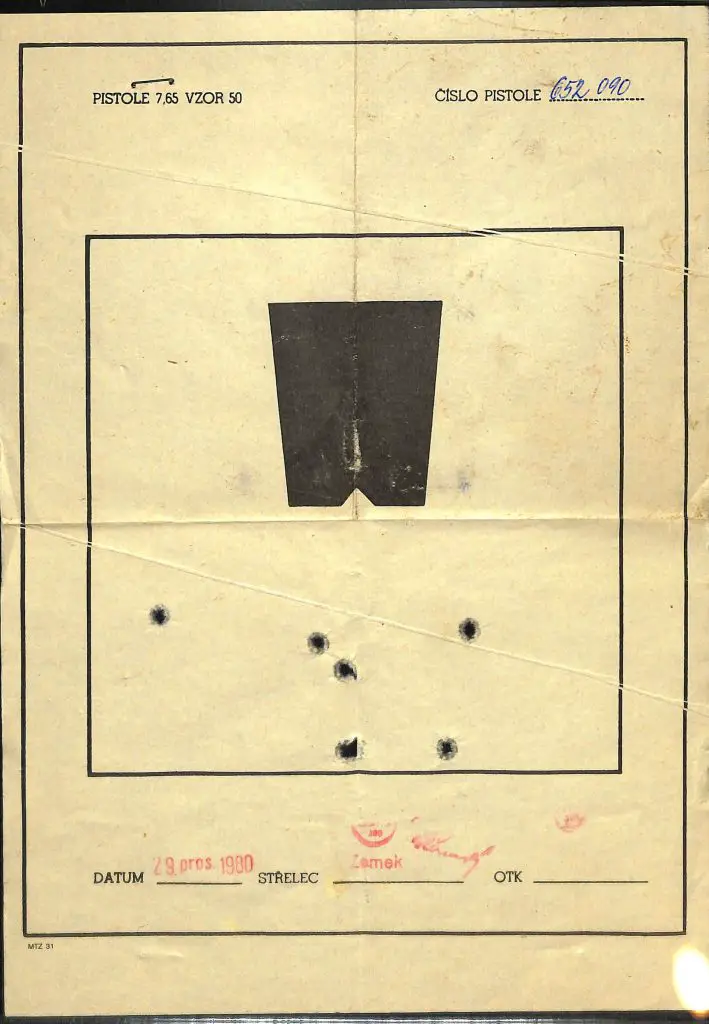 This makes perfect sense, as the two pistols have only cosmetic differences; most of the running changes in these small police pistols were made during the vz. 50 years. A late vz. 50 is more like a vz. 70 than it is like an early vz. 50. There are six shots on the target, one a flyer to the left. The legend at top reads: PISTOL 7.65 MODEL 50 and PISTOL NUMBER 652090. The legend on the bottom reads DATE: 29 Dec 1980; SHOOTER: Zemek (with two partial, illegible rubber stamps, one circular and one a signature), and OTK with a rubber stamp which may be the “kissing lips” we discuss below. We would welcome any insight to the meaning of the acronym OTK, but suspect it’s some type of inspector.
This makes perfect sense, as the two pistols have only cosmetic differences; most of the running changes in these small police pistols were made during the vz. 50 years. A late vz. 50 is more like a vz. 70 than it is like an early vz. 50. There are six shots on the target, one a flyer to the left. The legend at top reads: PISTOL 7.65 MODEL 50 and PISTOL NUMBER 652090. The legend on the bottom reads DATE: 29 Dec 1980; SHOOTER: Zemek (with two partial, illegible rubber stamps, one circular and one a signature), and OTK with a rubber stamp which may be the “kissing lips” we discuss below. We would welcome any insight to the meaning of the acronym OTK, but suspect it’s some type of inspector. - The CZ-83 target is a CZ-75 target with the -75 legend scratched out with black ink, and a CZ-83 legend rubber-stamped in place.
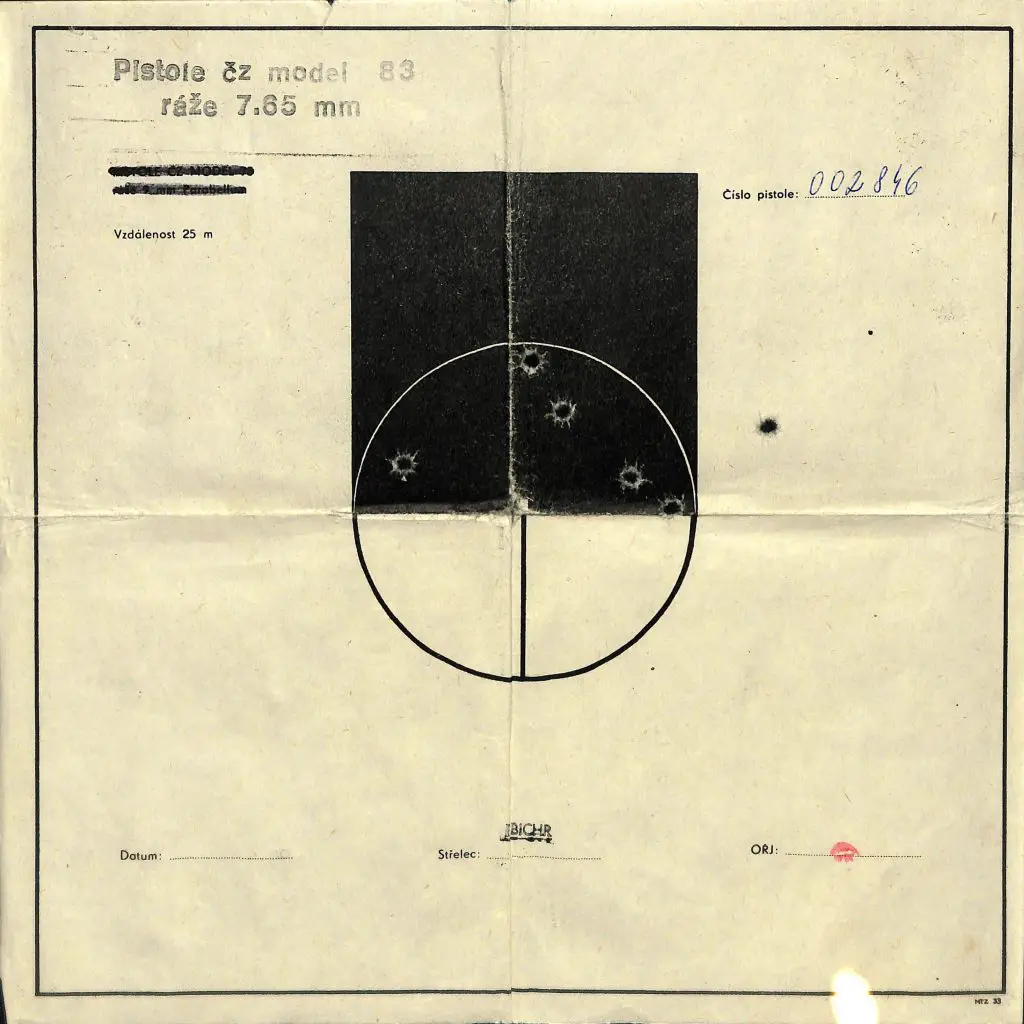 Whether a specific target was developed for the CZ-82/83 series is unknown; it’s possible, as this pistol has a four-digit serial number flagging it as first year production. The CZ-75 would have been the main export product of the Uhersky Brod plant when the -83 was introduced, and these targets would have been in daily use. On this target, the pre-printed CZ-75 lines (which you can read on the next target) are inked out, and a rubber stamp says Pistol čz model 83 caliber 7.65 mm. Below the inked-out CZ-75 lettering is Distance 25 m, and to the right is Pistol Number 002846. The legend on the bottom reads Date (blank) Shooter (stamp looks like JBICHR [?]), and OŘJ with a stamp we call the “kissing lips” but appears on magnification to be a blurred-out stamp that once had numbers or characters within it. It seems logical that OŘJ also refers to some inspector or inspection title, but again we do not know the Czech acronym.
Whether a specific target was developed for the CZ-82/83 series is unknown; it’s possible, as this pistol has a four-digit serial number flagging it as first year production. The CZ-75 would have been the main export product of the Uhersky Brod plant when the -83 was introduced, and these targets would have been in daily use. On this target, the pre-printed CZ-75 lines (which you can read on the next target) are inked out, and a rubber stamp says Pistol čz model 83 caliber 7.65 mm. Below the inked-out CZ-75 lettering is Distance 25 m, and to the right is Pistol Number 002846. The legend on the bottom reads Date (blank) Shooter (stamp looks like JBICHR [?]), and OŘJ with a stamp we call the “kissing lips” but appears on magnification to be a blurred-out stamp that once had numbers or characters within it. It seems logical that OŘJ also refers to some inspector or inspection title, but again we do not know the Czech acronym. - The target with the 1987-production CZ-75 (pre-B, which dates to 1992) is the same basic one used for the CZ-83 above, obviously without the CZ-83 adaptations.
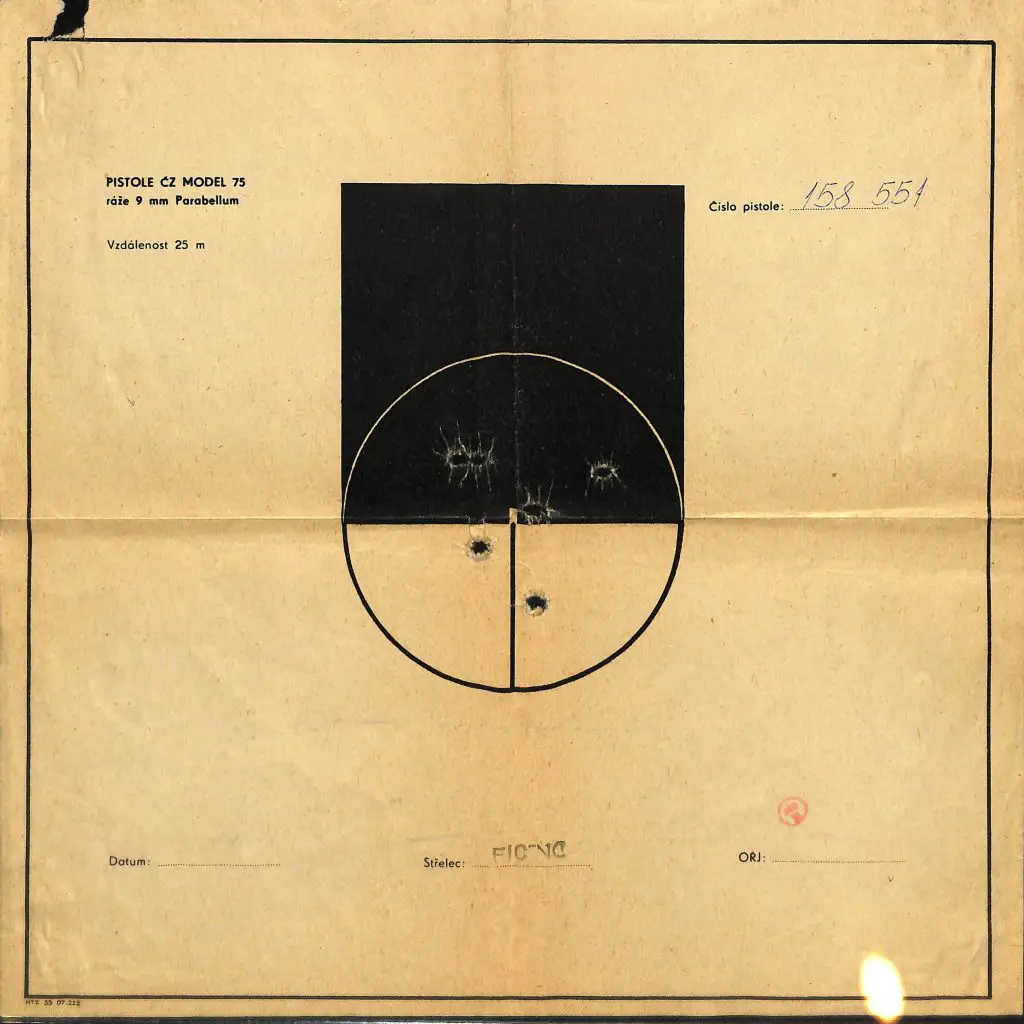 The legend inked out in the -83 target is seen to read PISTOL ČZ Model 75, Caliber 9 mm Parabellum, and the SHOOTER stamp at bottom center reads FICE[?]NC. The OŘJ stamp can be seen to be a circle with illegible characters inside (we liked it better when we thought it was kissing lips! From Moravia with love!). Seven shots appear to have hit this target, unlike the six of the two earlier ones. It is possible that this target is more “weathered” than the older CZ-83 target because the gun reached its end buyer in 1987, while the CZ-83 remained in one warehouse or another until 2017.
The legend inked out in the -83 target is seen to read PISTOL ČZ Model 75, Caliber 9 mm Parabellum, and the SHOOTER stamp at bottom center reads FICE[?]NC. The OŘJ stamp can be seen to be a circle with illegible characters inside (we liked it better when we thought it was kissing lips! From Moravia with love!). Seven shots appear to have hit this target, unlike the six of the two earlier ones. It is possible that this target is more “weathered” than the older CZ-83 target because the gun reached its end buyer in 1987, while the CZ-83 remained in one warehouse or another until 2017. - The P-01 is a modern computerized target that depicts the fall of the shots graphically on an ordinary sheet of A4 computer paper, and contains a great deal more information than the old targets.
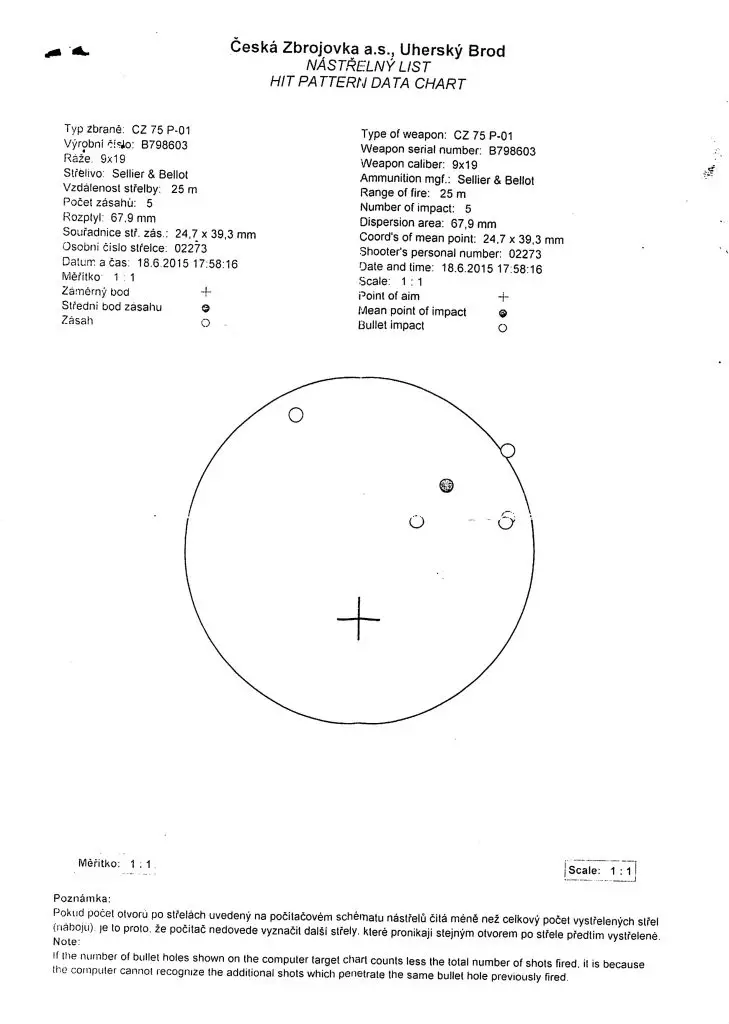 There is no point in translating any of the Czech, as CZ-UB has helpfully done it for us. This target represents the impact of five shots by white circles. The blackened circle is the calculated center of the group.
There is no point in translating any of the Czech, as CZ-UB has helpfully done it for us. This target represents the impact of five shots by white circles. The blackened circle is the calculated center of the group.
That the new targets are labeled in English as well as Czech is a nod to CZ’s export focus these days; printing them on an ordinary A4 sheet of computer paper and generating them by computer saves time and money at a busy factory, yet gives buyers confidence that their firearm has been tested and worked. (Europeans still have to proof-test their firearms, but we suspect many American firearms leave factories without every cycling a live round).
The Cold War era targets are (sparsely) labeled in Czech only, and are printed on extremely coarse and flimsy Warsaw Pact era paper, which has, as you can see here, yellowed to one degree or other with age. They do have a certain character. If we didn’t want to keep these in the boxes the firearms came in, we might just frame them. How much of the dirt, oil etc. on these fairly dirty targets came from the range and how much from the intervening decades of handling is anyone’s guess.
All targets are serial numbered to the guns, usually with blue ballpoint ink, and have a space for the technician who fired the gun to stamp his name and the date. Both of these stamps are seldom present, but the serial number has always been.
One open question is whether targets like these were furnished with domestic police and military firearms. Our tentative hypothesis is that they were not; instead, the military (etc) acceptance stamp went on when the ordnance officer was satisfied, and there was no point in retaining a target beyond that. None of the CZs we have with Czech military or police acceptance marks came with targets, but all were used (most, well-used) when we acquired them.
Update
We thought that we’d add this: if you’re lucky enough to have a date stamp on your CZ test target, the month will be abbreviated in Czech. Here is a table of the Czech months and the standard abbreviations for those months, which CZ used on its stamps.
Czech Months |
||
| English month | Česky (Czech) | ČZ Abbreviation |
| January | leden | led. |
| February | únor | ún. |
| March | březen | břez. |
| April | duben | dub. |
| May | květen | květ. |
| June | červen | červ. |
| July | červenec | červen. |
| August | srpen | srp. |
| September | září | zář. |
| October | říjen | říj. |
| November | listopad | list. |
| December | prosinec | pros. |
Watch out for June and July!

Kevin was a former Special Forces weapons man (MOS 18B, before the 18 series, 11B with Skill Qualification Indicator of S). His focus was on weapons: their history, effects and employment. He started WeaponsMan.com in 2011 and operated it until he passed away in 2017. His work is being preserved here at the request of his family.

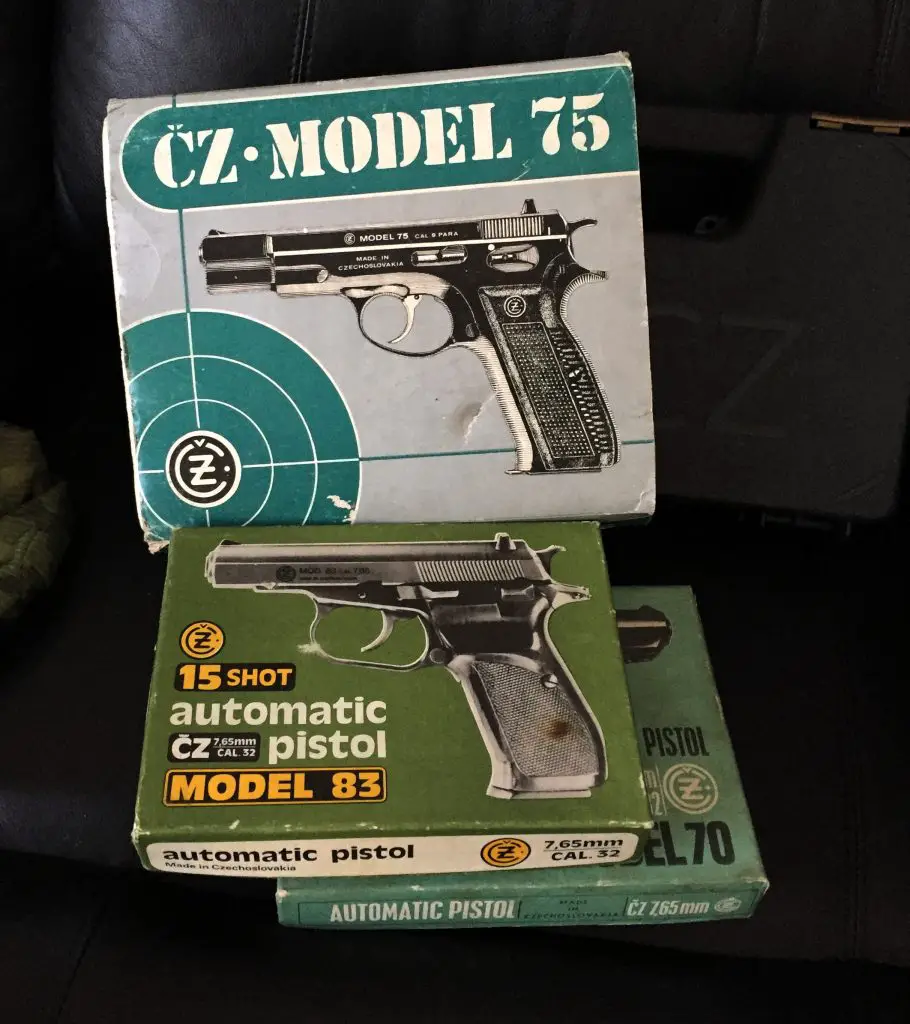
8 thoughts on “Understanding CZ Test Targets”
I bought some new old stock G3 slings a while ago; in the sealed plastic cover was a serial numbered info sheet for a rifle. I’ll have to look for them and see what they contained (I don’t remember what was on the paper or even how big it was).
Typos:
“aand”
“point descrining”
-John M.
Poland was tasked by Comecon to produce most pulp and paper for Warsaw Pact countries. The Czech’s enthusiastically blamed Poland for the sorry quality of the paper they had to use back in the day. Truth be told, the really good paper was reserved for propaganda screeds. Every other paper use was supplied with just awful product. Their toilet paper was especially memorable. You could get splinters from the stuff.
The paper yellowing is due to high sulphite content in the pulp which oxidizes the paper at an accelerated rate. East Bloc chemists knew this, but could never get the capital to install sulphite extraction equipment. Such capital in Comecon was always spent on defense follies and Potemkin Villages..
Technical details as they are, the yellowing adds a real character to the aged targets. It also could make some people (who might see any paper from the Warsaw Pact era) ask why the paper is so aged looking, which might make them read a bit of history…all in all a good thing.
***One open question is whether targets like these were furnished with domestic police and military firearms. Our tentative hypothesis is that they were not; instead, the military (etc) acceptance stamp went on when the ordnance officer was satisfied, and there was no point in retaining a target beyond that. ***
I think generally that you’re right. But the Česká zbrojovka Vz. 82 that I got to replace my East German PM after wifey grabbed it from me as her engagement present came from non-US [BATUS/Canada] non-commercial channels. It came oiled and plastic bag-wrapped, with cleaning rod, spare mags and tan holster in a separate poly bag, and inside the holster was a folded and rolled-up test target. I don’t read much Czech, minefield signs and ammo boxes aside, and maybe a few CZ and Janacek motorbike manuals. I wanted to know how it shot for me, so I grabbed some of her [FORMERLY MY] 9mm Makarov ammo and let fly. As per your notes, the factory target was marked as having been shot at 25 meters, so I did the same and was surprised to find I managed a group about an inch smaller than the factory shooter, not too shabby for my first time out with it. Think I may take it out for a romp when I carry qualify again next April.
Thought the Czech nomenclature chart for the ’82 might be of interest. If not, delete away!
I think they underpromise and overdeliver with the accuracy. Like I said, the technicians just rip the shots off to show the gun works and shoots about to point of aim at 25m
That’s an iinteresting point and would explain why my CZ-75 always shot way better in my hands than the test target would indicate. It always bugged me because I assumed they did it from some sort of machine rest, but if they just point Betsy downrange and let rip that explains the relatively poor group on my test target.
FWIW, Walther still supplies test targets with their guns. I received one with my PPQ.
OTK is a stamp of acceptance from the Soviet Military. “Office of Technical Control” is the English equivalent. You see it on all manner of Soviet era goods. I first ran across it on vacuum tubes. Some of the codes are followed by a month stamp some are not.